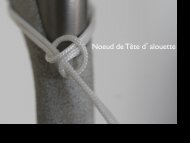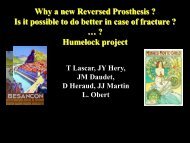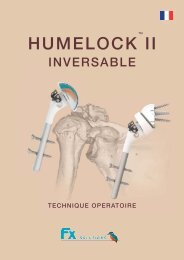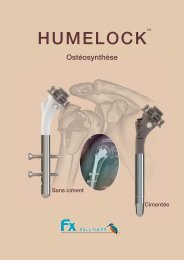humelock ii humelock reversed - fx solutions
humelock ii humelock reversed - fx solutions
humelock ii humelock reversed - fx solutions
Create successful ePaper yourself
Turn your PDF publications into a flip-book with our unique Google optimized e-Paper software.
EASYTECH<br />
HUMERIS<br />
LONG<br />
STEM<br />
200mm<br />
HUMELOCK II<br />
HUMELOCK II<br />
REVERSIBLE<br />
HUMELOCK<br />
REVERSED<br />
1
TABLE OF CONTENTS<br />
1. ANATOMICAL REMINDERS OF SHOULDER ARTICULATION<br />
Gleno-humeral articulation<br />
Rotator cuff and biceps<br />
2. PATHOLOGICAL CONSEQUENCES ON ANATOMICAL SHOULDER OMARTHRITIS<br />
Degenerative omarthritis<br />
Superior glenoid wear<br />
3. THERAPEUTICAL TREATMENT TO OBTAIN A MOBILE AND PAINLESS SHOULDER<br />
4. WHAT IS AN ANATOMICAL SHOULDER PROSTHESIS?<br />
Principal<br />
Historical<br />
Changing ideas<br />
5. WHAT IS A REVERSED SHOULDER PROSTHESIS?<br />
Principal<br />
Historical<br />
Pr Grammont<br />
6. THERAPEUTICAL INDICATIONS<br />
Prosthesis choice<br />
7. ALGORITHME Fx SOLUTIONS<br />
2
GLENO-HUMERAL ARTICULATION<br />
3
ROTATOR CUFF<br />
Rotator cuff has a coaptation role which means it keeps the<br />
humeral head against the glenoid while the muscles<br />
stronger take care of the movements.<br />
4
CENTERED ARTHRITIS<br />
If arthritis is linked to mechanic<br />
articulation use, it is a centered<br />
arthritis : the bone is damaged but<br />
rotator cuff (muscles) is working.<br />
5
SUPERIOR GLENOID WEAR<br />
Superior glenoïd wear :<br />
Tears of rotator cuff (muscles).<br />
The humeral head went up is no more<br />
centered against the glenoïd.<br />
6
THERAPEUTICALS TREATMENTS<br />
REMINDER<br />
It exists orthopaedic treatments however after failure among<br />
those, arthroplasty is used.<br />
CENTERED ARTHRITIS<br />
Anatomical prosthesis with or without glenoïd arthroplasty.<br />
We rebuild anatomy with existing rotator cuff.<br />
SUPERIOR GLENOID WEAR<br />
Tears of rotator cuff (supra spinatus) : Reversed prosthesis<br />
7
ANATOMICAL SHOULDER PROSTHESIS<br />
PRINCIPAL<br />
Anatomical shoulder prosthesis reproducts<br />
natural articulation (anatomy) with humeral<br />
part and glenoïd part. It needs a rotator cuff<br />
in good shape.<br />
HUMELOCK II<br />
Post op X-‐ray <br />
8
ANATOMICAL REVERSIBLE PROSTHESIS<br />
HUMELOCK II<br />
REVERSIBLE<br />
Post op X-‐ray <br />
9
ANATOMICAL SHOULDER PROSTHESIS<br />
HISTORICAL<br />
The first shoulder prosthesis has<br />
been created in 1893.<br />
HUMELOCK II<br />
Charles Neer put the first anatomical shoulder<br />
prosthesis on a fracture, in vitallium, monobloc,<br />
and reproduce the anatomy of the humeral<br />
epiphysis with a head size 44 (Neer I).<br />
10
ANATOMICAL SHOULDER PROSTHESIS<br />
CHANGING IDEAS<br />
To keep the maximum of bone, stemless<br />
have appeared few years ago. The<br />
results are astonishing.<br />
The conversion in <strong>reversed</strong> prosthesis is<br />
possible in case of rotator cuff damage.<br />
EASYTECH<br />
Post op X-‐ray <br />
11
ANATOMICAL REVERSIBLE PROSTHESIS<br />
EASYTECH<br />
REVERSIBLE<br />
Post op X-‐ray <br />
12
ANATOMICAL REVERSIBLE PROSTHESIS<br />
HUMERIS<br />
ANATOMICAL<br />
REVERSED<br />
13
Pr. Paul GRAMMONT (1940-2013)<br />
In 1985, Grammont designed a<br />
reverse prosthesis for arthritic<br />
shoulders with severe destruction<br />
of the cuff, in which standard<br />
anatomic prostheses could not<br />
solve the problem of restoring both<br />
joint stability and mobility.<br />
He published his first paper on the<br />
reverse prosthesis in the French<br />
literature in 1987.<br />
The concept of the reverse<br />
prosthesis developed by<br />
Grammont was a major step<br />
forward in the field of shoulder<br />
arthroplasty.<br />
14
REVERSED SHOULDER PROSTHESIS<br />
PRINCIPAL<br />
The male part will be fixed on the scapula<br />
and the female part on the humerus.<br />
This design is used to stabilize the<br />
articulation and work without the rotator cuff.<br />
However, we keep the tuberosities to insure<br />
a better mobility and stability in trauma.<br />
Post op X-‐ray <br />
HUMELOCK<br />
REVERSED<br />
15
REVERSED SHOULDER PROSTHESIS<br />
HISTORICAL<br />
The story of the reverse starts in 1970 with the<br />
prosthesis of Neer-Averill.<br />
1972: Reeves<br />
1972: Gérard and Lannelongue<br />
1973: Kölbel<br />
1973: Kessel<br />
1973: Bayley-Walker<br />
1975: « Jefferson » of Fenlin<br />
1975: « Liverpool » of Beddow<br />
1978: Buechel-Pappas-De-Palma<br />
1978: Gristina<br />
1985: 1 st model of Grammont<br />
1989: 2 nd model of Grammont<br />
2011: Humelock Reversed of Tristan Lascar<br />
and Laurent Obert<br />
HUMELOCK<br />
REVERSED<br />
16
THERAPEUTICALS INDICATIONS<br />
The choice of implanting a prosthesis will be defined in<br />
function of several parameters :<br />
Failure of a medical treatment well conducted<br />
Causes of the articulation destruction<br />
Bone and cartilage wear out<br />
Rotator cuff tears<br />
Age, health, sickness<br />
Exams results<br />
17
18
19







